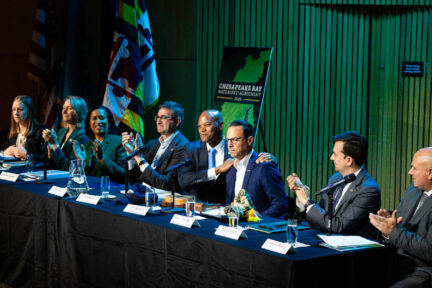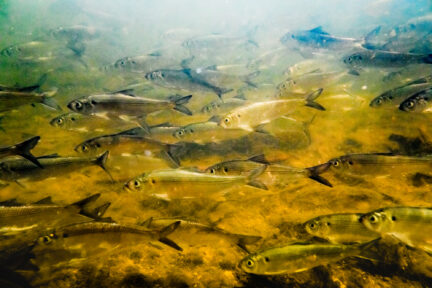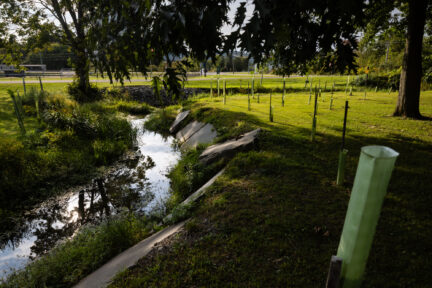Underwater Grass Abundance Declines for Second Year in a Row
Underwater Grass Abundance Declines for Second Year in a Row
In 2020, the preliminary figure of 62,169 acres of underwater grasses was mapped in the Chesapeake Bay and its tidal tributaries, achieving 48% of the Chesapeake Bay Program’s 2025 restoration target of 130,000 acres and 34% of the ultimate restoration goal of 185,000 acres.
Although the 62,169 acres of underwater grasses observed in 2020 have increased from the 38,958 acres noted during the first survey in 1984, it is a 20% decrease from the current 10-year average of 78,168 acres. The preliminary acreage observed in 2020 is a 42% decline from 2018 when it was estimated that the Bay may have supported up to 108,078 acres of underwater grasses. While this is a staggering decrease, the loss from 2019 to 2020 was only 7%, suggesting that overall, underwater grass beds are beginning to stabilize after a difficult past few years.
In 2020, the largest decline in terms of total area—an estimated 5,684 acres—was again observed in moderately salty waters, particularly in the Tangier Sound, but also in the Eastern Bay, the mouth of the Choptank River and in the Little Choptank River. These losses are largely attributed to the continued decline in widgeon grass, which fluctuates from year-to-year as the species responds rapidly to impacts from extreme weather and changes in water quality.
Underwater grass abundance can vary from species to species and river to river. In 2020, local highlights included:
- Upper Eastern Shore (Maryland): In 2020, the Sassafras River lost most of the new grasses that it had gained in 2019, decreasing from 406 acres to 169 acres. Similarly, the Chester River lost nearly 900 acres of grasses from 2019 to 2020, dropping from 1,616 acres to 734 acres.
- Middle Chesapeake Bay: Although underwater grass acreage in Virginia’s portion of Tangier Sound decreased substantially from the previous year, the abundance of grass beds in Maryland’s portion of Tangier Sound actually increased from 4,315 acres in 2019 to 4,725 acres in 2020. In the nearby Manokin River, underwater grass acreage increased from 583 acres in 2019 to 696 acres in 2020. The Little Choptank River, also in the middle of the Bay, decreased from 1,503 acres in 2019 to 550 acres in 2020 due to the loss of most of its widgeon grass.
- Northern Maryland: Underwater grass abundance in and around the Susquehanna Flats region increased from 8,497 acres in 2019 to 9,194 acres in 2020. Additionally, the Northeast River increased from 87 acres in 2019 to 109 acres in 2020.
- Washington, D.C.: Underwater grass abundance in the Anacostia River continued its resurgence and increased from 48 acres in 2019 to 53 acres in 2020.
- Mid-to-Lower Chesapeake Bay: In the Virginia portion of the mid-to-lower Bay, underwater grass abundance did particularly well in the Potomac and Rappahannock rivers, as well as in Mobjack Bay. The Potomac River increased from 6,631 acres in 2019 to 7,534 in 2020, while the Rappahannock, including the Corrotoman River, increased from 1,789 acres in 2019 to 2,204 acres in 2020. In Mobjack Bay, underwater grass acreage increased from 5,027 acres in 2019 to 7,080 in 2020
To learn more about our progress toward achieving and sustaining 185,000 acres of underwater grasses Bay-wide, visit ChesapeakeProgress.
Facts
Underwater grasses in the Chesapeake Bay are measured and calculated each year by an aerial survey conducted by the Virginia Institute of Marine Science. In some instances, satellite imagery may be used to complement the results from the aerial survey.
The Chesapeake is grouped into four different salinity zones to better reflect the various communities of underwater grasses that are found in the Bay.
Experts reported the following changes in the Bay’s four salinity zones between 2019 and 2020:
- Bay grass abundance in the Bay’s fresh waters (Tidal Fresh Salinity Zone) increased from 17,618 acres to 18,478 acres, achieving 90% of the zone’s 20,602-acre goal.
- Bay grass abundance in the Bay’s slightly salty waters (Oligohaline Salinity Zone) decreased from 9,029 acres to 8,086 acres, achieving 78% of the zone’s 10,334-acre goal.
- Bay grass abundance in the Bay’s moderately salty waters (Mesohaline Salinity Zone) decreased from 28,061 acres to 22,377 acres, achieving 19% of the zone’s 120,306-acre goal.
- Bay grass abundance in the Bay’s very salty waters (Polyhaline Salinity Zone) increased from 11,975 acres to 13,228 acres, achieving 39% of the zone’s 33,647-acre goal.
Issues
Like grasses on land, underwater grasses need sunlight to survive. When the waters of the Chesapeake Bay become clouded with algae blooms or suspended sediment, sunlight cannot reach the bottom habitat where these grasses grow. While healthy grass beds can trap and absorb some nutrient and sediment pollution— thus improving water clarity where they grow—too much pollution can cause grass beds to die off. High water temperatures, turbulence from strong storms and drought can also affect the growth and survival of underwater grass beds. Chesapeake Bay Program partners are working to improve water clarity, protect and restore grass beds, enhance bay grass monitoring and research and expand education and outreach to restore underwater grasses and boost their habitat benefits in the watershed.
Importance
Underwater grasses—also known as submerged aquatic vegetation or SAV—are critical to the Chesapeake Bay ecosystem. They keep our waters clean by absorbing excess nutrients, trapping suspended sediment and slowing wave action that helps to stabilize shorelines, protect wetlands and reduce erosion. Bay grasses also provide food for small invertebrates and migratory waterfowl and habitat for fish and blue crabs. In fact, bay grass abundance is one of several factors that can impact the health and stability of the blue crab population: the loss of these grasses is a loss of nursery habitat which can increase their vulnerability by pushing young crabs to gather in the limited nurseries that remain. In the 2021 Blue Crab Advisory Report, the population of juvenile blue crabs decreased from 185 million in 2020 to 86 million in 2021. Researchers that study underwater grasses believe that a contributing factor to the decline of the juvenile blue crab population is the decrease of grass beds from 2018—2020.
Overall, the blue crab population in the Bay decreased from 405 million in 2020 to 282 million in 2021. While this marks approximately a 31% decrease from the previous year, experts report the overall Chesapeake Bay blue crab population is not depleted or being overfished. An estimated 41.6 million pounds of blue crabs were commercially harvested from the Chesapeake Bay in 2020, which is a decline from the 61 million pounds harvested in 2019. Recreational crabbers harvested roughly 2.4 million pounds in 2020, a decrease from the 3.8 million pounds harvested in 2019.
Because Bay grasses are sensitive to climate conditions and pollution but quick to respond to water quality improvements, their abundance is a good indicator of Bay health. To support the resurgence of underwater grass beds in the Bay, cities and towns can reduce polluted runoff and upgrade wastewater treatment plants with pollution-reducing technologies, farmers can use conservation practices to keep fertilizers in their fields, boaters can steer clear of bay grass beds that are growing in shallow waters, waterfront landowners can limit hardened shorelines where possible and homeowners can use rain barrels or rain gardens to slow the delivery of nutrient- and sediment-laden stormwater runoff into the Bay.
Quotes
"2020 was another rough year for the Bay's underwater grasses, which is disappointing after we witnessed such impressive gains in acreage, density and diversity between 2012 and 2018. The loss was minimal compared to that in 2019, however, and there were still areas that remained stable and resilient, which is a big relief. I think the main lesson learned from the 2020 data is that we still have a lot of work to do. We need to sustain the efforts we've already made—because we know those efforts have paid off—but in the face of climate change, we're going to need to do more. It's not just about nutrient and sediment pollution anymore; it's managing those things plus dealing with all of the other stressors associated with climate change. It's daunting but saving the Bay's underwater grasses is absolutely worth it."
- Brooke Landry, Chair, Chesapeake Bay Program SAV Workgroup and Natural Resource Biologist, Department of Natural Resources, State of Maryland
“While the 7% decline is disappointing, the silver lining is that the 2020 survey shows that underwater grasses are stabilizing following the losses experienced in the middle Bay in 2019. We are hopeful that this is a sign that we’re poised to start regaining that lost ground in coming years. As to why we lost grasses again, the continued decline in 2020 is again attributable to widgeon grass. It is becoming imperative that we learn more about the life history and biology of this species, as our hope of continued underwater grass recovery in much of the Bay is becoming increasingly tied to the success or failure of this one species.”
- Chris Patrick, Head of the Chesapeake Bay SAV Monitoring and Restoration Program and Assistant Professor of Biology, Virginia Institute of Marine Science, College of William and Mary



